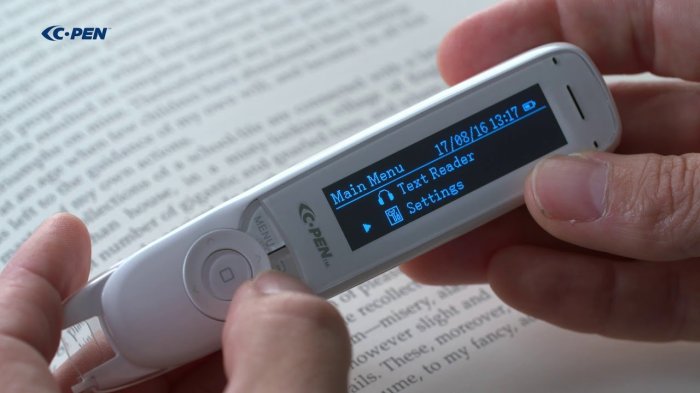Literacy pen tech read and write – Literacy Pen Tech: Read, Write, and Thrive is a journey into the evolving landscape of writing and reading, where the lines between traditional and digital tools blur. From the ancient quill to the modern digital pen, we’ll explore how technology has shaped our ability to communicate and learn.
This exploration will uncover the benefits and challenges of using digital pens in education, examine the impact of technology on reading comprehension, and peek into a future where literacy is intricately woven with technology.
This blog delves into the fascinating world of literacy pen technology, examining its evolution, impact on learning, and potential for shaping the future of education. We’ll explore how these innovative tools are bridging the gap between traditional and digital literacy, empowering learners with new ways to express themselves and engage with information.
Evolution of Writing Tools

The ability to write has been a cornerstone of human civilization, enabling the preservation of knowledge, communication across distances, and the development of complex societies. From the earliest cave paintings to the digital documents of today, writing tools have evolved alongside human ingenuity, reflecting our changing needs and technological advancements.
The Rise of Traditional Writing Tools
The earliest forms of writing involved scratching symbols onto surfaces like clay tablets or stone. The invention of papyrus in ancient Egypt marked a significant leap forward, providing a more portable and readily available writing surface. The use of reeds as pens, dipped in ink made from natural pigments, further enhanced the writing experience.
- Quills: Made from bird feathers, quills were the dominant writing tool in Europe during the Middle Ages. Their flexible nibs allowed for a range of line thicknesses, enabling a more expressive writing style. However, quills required constant sharpening and were prone to breakage, limiting their practicality.
- Pens: The invention of the steel pen in the 18th century revolutionized writing. Steel pens were more durable, consistent, and readily available than quills, making writing accessible to a wider population. The development of fountain pens in the late 19th century further improved writing convenience, allowing for continuous ink flow without frequent dipping.
- Typewriters: The invention of the typewriter in the late 19th century marked a significant shift towards mechanical writing. Typewriters allowed for faster and more legible writing, particularly for business and professional purposes. However, their limited flexibility and the need for specialized skills restricted their widespread use.
The Digital Revolution in Writing
The advent of computers and digital technology in the 20th century brought about a profound transformation in writing. Word processing software offered unparalleled flexibility, allowing for easy editing, formatting, and storage of documents. The development of personal computers and laptops made writing accessible to a broader audience, while the rise of smartphones and tablets further democratized access to digital writing tools.
- Tablets: Tablets offer a portable and intuitive platform for writing, combining the ease of pen and paper with the versatility of digital tools. They allow for handwriting recognition, digital drawing, and seamless integration with other applications. However, their smaller screens and reliance on touch input can be limiting for extended writing sessions.
Understand how the union of sweden scania world first solar panel covered truck can improve efficiency and productivity.
- Laptops: Laptops provide a larger screen, more robust hardware, and a wider range of software options for writing. They are well-suited for complex documents, research, and creative writing projects. However, their larger size and limited portability can be drawbacks in certain situations.
Key Advancements in Writing Technology
Several technological advancements have significantly impacted literacy and communication:
- Printing Press: Johannes Gutenberg’s invention of the printing press in the 15th century revolutionized the dissemination of knowledge. The ability to mass-produce books made literacy more accessible, leading to the spread of ideas and the growth of education.
- Computer and Internet: The development of computers and the internet in the 20th century has enabled unprecedented levels of communication and information sharing. Digital writing tools have made it easier to create, edit, and distribute content globally, fostering collaboration and knowledge exchange.
- Speech Recognition Software: Speech recognition software allows users to dictate text directly into computers and mobile devices. This technology has opened up writing to individuals with physical limitations and has made it easier to create content on the go.
The Impact of Digital Pens on Literacy
Digital pens, a modern iteration of writing tools, have emerged as a powerful force in the realm of literacy. These devices, capable of capturing handwritten notes and converting them into digital formats, have introduced new avenues for learning and communication.
Benefits of Digital Pens for Writing and Learning, Literacy pen tech read and write
Digital pens offer a range of advantages that can enhance writing and learning experiences. They provide a seamless bridge between traditional pen-and-paper writing and the digital world, offering a unique blend of familiarity and technological advancement.
- Enhanced Note-Taking:Digital pens enable users to take notes directly on paper, with the added benefit of capturing the notes digitally. This allows for easy organization, editing, and sharing of notes, eliminating the need for manual transcription.
- Improved Handwriting:Studies have shown that using digital pens can improve handwriting skills. The immediate feedback provided by the device, such as highlighting errors or suggesting corrections, can help learners refine their penmanship.
- Accessibility and Inclusivity:Digital pens offer a range of accessibility features, such as voice-to-text capabilities and adjustable pen pressure settings, making them suitable for individuals with disabilities or learning differences.
- Enhanced Collaboration:Digital pens can facilitate collaborative learning experiences. Students can share their notes and ideas in real-time, fostering discussion and knowledge exchange.
Drawbacks of Digital Pens
While digital pens offer numerous advantages, it is essential to acknowledge potential drawbacks:
- Cost:Digital pens and accompanying software can be expensive, potentially posing a financial barrier for some individuals and institutions.
- Technological Dependence:The functionality of digital pens relies on technology, making them susceptible to technical issues and requiring access to compatible devices and software.
- Learning Curve:Learning to use a digital pen effectively may require some initial training, which could be a challenge for some users.
- Limited Functionality:Some digital pens have limited functionality, such as the inability to edit or annotate text directly within the digital format.
Use of Digital Pens in Educational Settings
Digital pens are finding increasing applications in educational settings, where they are being used to enhance literacy skills across various subjects.
- Language Arts:Digital pens can be used to facilitate creative writing activities, allowing students to experiment with different fonts, colors, and styles. They can also be used for interactive exercises, such as grammar drills and vocabulary quizzes.
- Mathematics:Digital pens can help students visualize mathematical concepts and solve problems. For example, students can use the pens to draw diagrams, graphs, and equations, which can then be saved and shared with others.
- Science:Digital pens can be used to take notes during science experiments, record observations, and create interactive diagrams. The digital format allows students to easily share their findings with classmates and teachers.
- Social Studies:Digital pens can enhance the study of history and geography by allowing students to create timelines, maps, and annotated texts. The ability to share and collaborate on these projects can foster deeper understanding and engagement.
Bridging the Gap Between Traditional and Digital Literacy
Digital pens play a significant role in bridging the gap between traditional and digital literacy. They offer a familiar and comfortable writing experience while leveraging the power of technology to enhance learning and communication.
- Blending Traditional and Digital:Digital pens allow students to write naturally on paper, while simultaneously capturing their notes in a digital format. This seamless integration fosters a balance between traditional and digital literacy practices.
- Enhancing Engagement:The interactive nature of digital pens can increase student engagement by offering a more dynamic and engaging learning experience. The ability to share notes, collaborate on projects, and access digital resources can make learning more interactive and enjoyable.
- Developing Digital Skills:Using digital pens can help students develop essential digital skills, such as digital note-taking, file management, and online collaboration. These skills are increasingly important in today’s digital world.
The Role of Technology in Reading: Literacy Pen Tech Read And Write
The digital age has ushered in a new era of reading, where technology plays a pivotal role in enhancing comprehension, engagement, and accessibility. From e-readers to interactive learning platforms, various technological tools have transformed the way we read and interact with text.
The Benefits of Technology in Reading
Technology offers a multitude of ways to improve reading comprehension and engagement.
- Personalized Learning:Adaptive learning platforms adjust to individual reading levels and learning styles, providing personalized content and feedback. This tailored approach can enhance comprehension and motivation. For instance, platforms like Khan Academy and Duolingo utilize algorithms to track user progress and adjust difficulty levels accordingly, creating a personalized learning experience.
- Interactive Content:Digital texts can incorporate interactive elements like quizzes, games, and multimedia components, making reading more engaging and interactive. These elements can enhance comprehension by providing immediate feedback and encouraging active participation. For example, educational apps like “Reading Eggs” and “Starfall” use interactive games and animations to make learning phonics and reading fun and engaging for young learners.
- Accessibility and Convenience:E-readers and audiobooks provide convenient access to a vast library of books, regardless of location or physical limitations. This accessibility promotes reading for individuals with visual impairments, learning disabilities, or limited mobility. For instance, the “Bookshare” platform offers a vast collection of accessible books in digital formats, allowing individuals with print disabilities to enjoy reading.
E-Readers and Audiobooks: Transforming Reading Experiences
E-readers and audiobooks have revolutionized reading by offering a range of features that enhance reading fluency and enjoyment.
- Adjustable Text Size and Font:E-readers allow users to adjust text size and font to improve readability and reduce eye strain. This is particularly beneficial for individuals with visual impairments or those who prefer larger fonts. For example, Kindle e-readers offer a wide range of font options and text sizes, allowing users to customize their reading experience.
- Dictionary and Translation Tools:Many e-readers and reading apps integrate dictionaries and translation tools, allowing users to quickly look up unfamiliar words or phrases. This can enhance comprehension and vocabulary development. For instance, the “Oxford Bookworms Library” app provides integrated dictionaries and translation tools, enabling learners to access definitions and translations seamlessly while reading.
- Audiobooks: Engaging Listening Experiences:Audiobooks allow readers to listen to books while engaging in other activities, such as commuting or exercising. This can promote reading fluency and enjoyment for individuals who find it challenging to read traditional print books. For instance, platforms like Audible and Librivox offer a vast selection of audiobooks, catering to a wide range of interests and genres.
Literacy and Technology in the Future

Imagine a world where learning transcends the boundaries of traditional classrooms and textbooks. A world where technology seamlessly integrates with education, empowering individuals to unlock their full potential. This is the future of literacy, a future shaped by the ever-evolving landscape of technology.
The Evolution of Educational Environments
The future of education will be characterized by personalized learning experiences tailored to individual needs and learning styles. Digital pen technology, coupled with advanced artificial intelligence, will play a pivotal role in this transformation. Imagine a classroom equipped with interactive whiteboards, augmented reality simulations, and intelligent pen devices that can analyze handwriting, provide real-time feedback, and adapt to individual learning pace.
These tools will facilitate personalized instruction, allowing students to progress at their own pace and explore topics in depth.
- Adaptive Learning Platforms:AI-powered learning platforms will analyze student performance data and provide customized learning paths, ensuring that each student receives the appropriate level of support and challenge.
- Immersive Learning Experiences:Augmented and virtual reality technologies will create immersive learning environments, bringing historical events, scientific concepts, and literary worlds to life.
- Collaborative Learning Tools:Digital pen technology will enable seamless collaboration among students, fostering communication, teamwork, and shared learning experiences.
Skills and Knowledge for Success in a Technologically Driven Society
The skills and knowledge required for success in a technologically driven society will evolve significantly.
| Traditional Skills | Future Skills |
|---|---|
| Reading Comprehension | Critical Thinking and Problem-Solving |
| Writing Skills | Digital Literacy and Communication |
| Memorization | Creativity and Innovation |
| Following Instructions | Adaptability and Resilience |
| Working Independently | Collaboration and Teamwork |
- Digital Literacy:The ability to navigate and utilize digital tools effectively will be essential for accessing information, communicating, and collaborating in a technology-driven world.
- Critical Thinking:The ability to analyze information, identify biases, and form well-reasoned conclusions will be crucial for navigating a world saturated with data.
- Problem-Solving:The ability to identify and solve complex problems, both independently and collaboratively, will be highly valued in the future workforce.
- Adaptability:The ability to learn new skills and adapt to changing technologies and environments will be essential for success in a rapidly evolving world.



